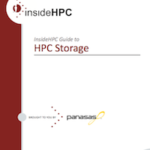insideHPC invites you to take our reader survey! Your feedback will help us keep publishing relevant content that HPC users and vendors need. In return for your generosity, you’ll be entered into a drawing for a $200 Amazon gift card. The survey only takes about five minutes to complete and will be greatly appreciated by […]
You’re Invited! Take the insideHPC Reader Survey
insideHPC invites you to take our reader survey, your feedback will help us keep publishing relevant content that HPC users and vendors need. In return for your generosity, you’ll be entered into a drawing for a $200 Amazon gift card. The survey only takes about five minutes to complete and will be greatly appreciated by […]
Veteran Technology Journalist Doug Black Named to Succeed Rich Brueckner as Editor of insideHPC
insideHPC Media has announced that veteran technology journalist Doug Black has been named editor-in-chief of insideHPC. Black succeeds the late Rich Brueckner, who purchased the property in 2010 and has been a prominent figure in HPC media ever since. Black has been a technology and business writer since 1985, serving in journalistic, marketing and public relations roles. He has been involved with the HPC community since 1991 and has worked on numerous technology announcements and media campaigns in support of companies, including Intel and SGI, throughout the HPC ecosystem.
Scratch to Supercomputers: Bottoms-up Build of Large-scale Computational Lensing Software
Gilles Fourestey from EPFL gave this talk at the Swiss HPC Conference. “LENSTOOL is a gravitational lensing software that models mass distribution of galaxies and clusters. It is used to obtain sub-percent precision measurements of the total mass in galaxy clusters and constrain the dark matter self-interaction cross-section, a crucial ingredient to understanding its nature.”
The Transformation of HPC: Simulation and Cognitive Methods in the Era of Big Data
Dave Turek from IBM gave this talk at the Swiss HPC Conference. “There is a shift underway where HPC is beginning to be addressed with novel techniques and technologies including cognitive and analytic approaches to HPC problems and the arrival of the first quantum systems. This talk will showcase how IBM is merging cognitive, analytics, and quantum with classic simulation and modeling to create a new path for computational science.”
Video: How MVAPICH & MPI Power Scientific Research
Adam Moody from LLNL presented this talk at the MVAPICH User Group. “High-performance computing is being applied to solve the world’s most daunting problems, including researching climate change, studying fusion physics, and curing cancer. MPI is a key component in this work, and as such, the MVAPICH team plays a critical role in these efforts. In this talk, I will discuss recent science that MVAPICH has enabled and describe future research that is planned. I will detail how the MVAPICH team has responded to address past problems and list the requirements that future work will demand.”
Infinite Memory Engine: HPC in the FLASH Era
In this RichReport slidecast, James Coomer from DDN presents an overview of the Infinite Memory Engine IME. “IME is a scale-out, flash-native, software-defined, storage cache that streamlines the data path for application IO. IME interfaces directly to applications and secures IO via a data path that eliminates file system bottlenecks. With IME, architects can realize true flash-cache economics with a storage architecture that separates capacity from performance.”
HPC Storage InsideHPC Guide
HPC and technical computing environments require the collection, storage, and transmission of large-scale datasets. To meet these demands, datacenter architects must consider how increasing storage capacity over time will affect HPC workloads, performance, and system availability.










